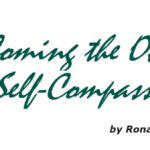
When I employ somatic kinesiology (muscle testing) to assess my clients’ inner truth regarding their self-compassion most go weak—they have little motivation for self-compassion. Many of these people work in professions where they successfully bring compassion to their clients, but, in turn, not to themselves. How can this be? And, more importantly, what can be done?
Compassion
To start, I think it’s useful to understand what compassion is and what it is not. My working definition of compassion represents tender, empathic, and caring sentiments. It involves loving feelings that emerge when an injury (physical, emotional, or spiritual) is recognized and nurtured. Compassion is bringing a concerned, reinforcing spirit in the presence of wounding.
caring sentiments. It involves loving feelings that emerge when an injury (physical, emotional, or spiritual) is recognized and nurtured. Compassion is bringing a concerned, reinforcing spirit in the presence of wounding.
Self-compassion is loving feelings directed to one’s self. According to Rick Hanson, Ph.D. and Richard Mendius, M.D. (2009), “Self-compassion isn’t self-pity but is simply warmth, concern and good wishes. Compassion has the potential to bring about emotional healing.”
Being self-compassionate is not being self-centered, egotistical, or narcissistic. Nor is it about self-esteem. Self-esteem is different from self-compassion. Self- esteem derives from what we do. It involves good feelings about ourselves that result from achievements performing a role at work or in a family. If overly identified with one’s self-esteem, it can lead one to feel grandiose, judgmental, and superior to others. Self-esteem can become confused with who we are our spirit as individuals. Maintaining the preciousness for who one is, along with the spirit that emanates from one’s self leads not only to feelings of joy but health and absence of depression despite wounding.
Kristin Neff, Ph.D. (2011) states that self-compassion is self-kindness. It involves recognition that our wounded feelings refect a common humanity. And our awareness of ourselves in self-compassion is mindful. Mindfulness is not just thought but an awareness that thoughts, feelings, our body and our spirit are one. Compassion is tending to the mind.
As Neff indicates, mindfulness is a clear, non-emotionally biased perception of our present vision. Being human is being imperfect. This leads to a sense of unity with humanity. Being accepting of this allows us to see more perceptively rather than blurring our vision by self-depreciation. It provides a sense of reality, safety.
Compassion as a healing agent
Compassion can be a healing intervention for individuals suffering from external or internal life injuries or wounds. Christopher Germer, Ph.D. (2009) believes that there are two aspects to overcoming wounds: mindful awareness and self-compassion. This rests on the belief that the mind is not merely the conscious prefrontal cortex of the brain but rather that the mind consists of: conscious awareness, unconscious memories, the hippocampus, the amygdala, the vagus nerve, muscles, neuro-networks, the stomach, adrenal glands, and skin. All of which are part of bodily systems that either communicate or withhold the expression of feelings.
If individuals are wounded and feel compassion for themselves, they typically remain free from negativity, anger, and self-withdrawal. When people are compassionate with themselves versus being negative and entering a sympathetic fight, fight, or freeze mode, they remain in a parasympathetic mode associated with rest, digest, and recover. They are open to self-perception, creativity, and growth, and to perceiving opportunities rather than maintaining a closed mind. Self- compassionate individuals have the potential for enthusiasm, interest, inspiration, and excitement more so than those who are self-critical. They have the potential to be more optimistic and their gratitude can then lead to joy. This means they tend to be less anxious and depressed. Compassion tends to minimize rumination. These individuals often have fewer negative feelings and lower heart rates.
The origin of opposition to self-compassion
Compassion, in action, has two components. First, it is perception of a wound or injury. Second, it is empathy and love for that wounded person or wounded people. It is eliminating one’s defensive reaction to a painful situation and opening to consideration and kindness. To be able to have these feelings one must be sensitive to their own perceptions, open to their feelings and those of others, and be willing to respond to positive, nurturing awarenesses.
To generate self-compassion, one must recognize it is not merely generating emotionless  words (thought or spoken) to one’s self. It is a sense of spirit that embodies what is fully felt and experienced in addition to thought and/or spoken words. Self-compassion derives from the spirit and the body, as well as from words emanating from one’s left brain. Words that are not emotionally and somatically experienced are powerless.
words (thought or spoken) to one’s self. It is a sense of spirit that embodies what is fully felt and experienced in addition to thought and/or spoken words. Self-compassion derives from the spirit and the body, as well as from words emanating from one’s left brain. Words that are not emotionally and somatically experienced are powerless.
A foundation of positive self-compassion needs to taught and nurtured from birth on. Most parents possess an instinctive disposition that engenders warmth, support, and compassion; they nurture and protect their children. Unfortunately, many parents were also unrecognized, under supported, and not reinforced by their own parents. They can’t pass on knowledge that wasn’t role modeled for them. So, generationally speaking, this sense is often not recognized, instilled, reinforced, nor celebrated in childhood. Thus, many traits, skills, and talents that children have go unrecognized and unappreciated. They simply do not develop. These children grow up internalizing their parents’ unhealthy role models. They might even believe that in order to be accepted their role is to take care of others. Because of this disconnect, internal integrity remains undeveloped and unappreciated. This leads to a lack of development in the personality and a minimization of self-appreciation and yet other symptoms.
To further complicate things, there are also parents whose anger and hostility regarding their own lives spill over as they punitively displace their resentment onto their children. Their children then believe that there is something basically wrong with them. They often end up thinking, Why else would my parents act that way?
As a result of these childhood experiences and resultant wounds, they are unable to be compassionate and supportive toward themselves. They may even be self-punitive. Although self- compassion is a remedy for criticism, rejection, and diminishment, words and even actions not backed by feelings and spirit are powerless to remedy deep often unconscious emotional wounds.
These patterns are passed down generationally. And while it’s important to understand one’s parents’ role modeling, it is just as important to not blame them for what they did or did not do. Blaming gives away one’s strength and sense of command. But, recognizing one’s parents’ personalities can be extremely helpful for self- knowledge of one’s own identity, personality, and growth. It lets people know who and how they do not want to be and who and how they do want to be.
 Lacking Self Compassion
Lacking Self Compassion
An inability to provide one’s self with self-compassion is a symptom of an underlying wound or trauma. Therefore, minimizing the presenting symptom does not eliminate the underlying cause.
Imperfections (or life wounds) are often met with self-criticism, even condemnation. This leads to somatic bracing that further increases discomfort and pain, minimizing one’s potential. Internal frustration also arises as one can never achieve her or his goals. I recently identified what I call the sweetie-pie syndrome (Kisch, 2019). In short, even if one’s goals are met, a sweetie-pie never feels good enough so something else must be achieved. The problem is, if people believe they are not deserving, if they are unworthy of compassion or suffer from imperfection then compassion, even if offered, is defected, rejected, and not received, whether it comes from another or offered to one’s self. Healing does not occur. The wound continues. And, if the imperfection is contemplated over and over, it becomes deeper and more permanent and part of the individual’s personality. It inhibits compassion, self-worth, inner strength, healing, and growth.
To address the underlying cause an effective intervention is necessary that both identifies and addresses the cause and treats the wound that led to the holding pattern beneath the presenting problem or symptom. The psychophysical holding pattern must be released, and a new path taken.
One possible remedy
Wounds remain from dysfunctional, inadequate, or hostile parents or guardians. How does one transcend what happened in the past? That’s the question. When people have low self-esteem and do not self-confirm and do not believe they deserve compassion, they cannot feel compassion for themselves. The work does not involve blaming the other nor feeling sorry for one’s self. For healing and growth, self-compassion, recognition, confirmation, and transcendence must be done. Self-confirmation of one’s traits, skills, abilities, talents, and achievements solidify one’s sense of identity and strength. One must take action to reverse and heal past wounds allowing for reinforcement of one’s identity and strengths. This action involves significant mindful (thought, feeling, body and spirit) attention.
Self-compassion allows for calming and comfort. It may even allow for motivation to take further steps to treat the wound and heal what remains from the past cause. There are three steps to overcoming obstacles to self-compassion. The first is to identify the blocks to self-love and provide some action that provides warm supportive feelings to comfort the pain. The second is to release these blocks. And the third is to provide an alternative intervention, new skills and coping mechanisms to deal with life’s threats and wounds.
There are many well-established techniques and procedures that allow for somatic comforting and relaxation, e.g. self-touch, massage, Yoga, Tai Chi, Craniosacral work, and Trager® body work. However, each has limitations when addressing self-compassion. For instance, when someone is traumatized, enraged, or depressed as often experienced in my clinical setting, mindful meditation is not always possible. Post- traumatic thoughts and feelings reemerge with somatic stress and cognitive agitation. People cannot achieve a meditative state if they are not calm, relaxed, and focused. If someone is in shock or trauma, is upset or angry, they cannot be calm and open to loving feelings. Because of childhood or life wounds that many have endured, they do not believe they are worthy of self-compassion and are unable to achieve a meditative state.
And while Thought Field Therapy (TFT) and Eye Movement Desensitization Reprocessing (EMDR) are often used to minimize or eliminate troubling psychological distress, they do not identify and may not address age old, deeper causal variables connected to the event that results in a lack of self-compassion.
In my clinical practice, I use Dr. Scott Walker’s NeuroEmotional Technique (NET) (1996). This utilizes applied kinesiology-testing muscle strength as developed by Dr. George Goodheart in 1964. Dr. Walker’s procedure appears to be a particularly powerful intervention for identifying the presence and origin of emotional trauma. It utilizes Goodheart’s procedure to identify somatic meridian points and emotions that are connected to these meridian points. It utilizes visualization and respiration to extinguish the somato-emotional trauma.
In my office, I often hear many clients profess to have or to engage in self-compassion. However, when I apply somatic kinesiology—muscle testing—it is evident this is not true. Their arm muscles go weak; their arms actually go limp in my hands.
To demonstrate how the process works, I offer the following cases where poor parental role modeling, lack of reinforcement of preciousness and being deserving led to psychological wounding, low self-esteem, a paucity of integrity, and lack of belief in lovability. It also led to feelings of unworthiness of self-compassion. If these individuals were not doing for another, they had internalized feelings of unworthiness. They had  histories of reaching out to help others but not themselves.
histories of reaching out to help others but not themselves.
In the following cases, I used Milton Trager, M.D.’s work to identify and release physical holding patterns, Craniosacral Therapy developed by John Upledger, D.O. to assess and release holding patterns in the pathway between the cranium and the sacrum, and Neuro-Emotional Technique (NET) to release physical-emotional holding patterns from the past, as well as from the present. Talk therapy was then used to find new ways of confronting such problematic situations. Clients were also supported to have conversations with their younger selves, not to reprimand or give advice but to offer the compassion that was never offered in the past offering statements such as: “You are precious, lovable, and deserving. And you don’t have to do anything for it. You are one of God’s children.”
Case I
Joyce is a married 64-year-old who volunteers with abused, neglected, wounded children. She believes “my childhood wounds give me drive to do for others.” She is a sweetie pie; she gives to others but not herself. Her wounds come from what she describes as her “narcissistic mother”. She will not call her mother, “mother,” but talks about her by her first name – Rebecca. Her mother wanted a son; she had two daughters. Joyce, who is soft-spoken and non-verbal, was the first. She says, “It’s safe for me to keep my thoughts in my head. I keep them inside, then I don’t feel important and a threat to my mother.” This minimizing behavior projects throughout her relationships.
Joyce pulls out her cell phone and shows a quote from Shahida Arabi. Joyce explains that the quote suggests that children who are abused by parents don’t blame the parents but stop loving themselves. Joyce said, “It was my truth when I read it.”
Joyce also presented in her psychotherapy treatment session with left-sided neck pain. When NET was applied, her neck pain was related to internalized “anger” toward Rebecca. “Just hearing her voice hurt me,” she said. Muscle testing took this wounding back to the age of one. NET extinguished the emotional holding pattern and the physical neck pain.
Post-treatment Joyce is somatically strong with the statement, “I deserve giving myself compassion.” This soft-spoken, passive woman was feeling strong enough to confront her younger sister, her mother’s companion, and set a boundary: “I do not want to have contact with Rebecca at family events. Rebecca is toxic.” Joyce did not go to the next family event. Joyce is also strong enough to admit she was sexually molested by her uncle, her mother’s brother. Joyce took on a new appearance – soft, calmer, more relaxed. She felt more comfortable expressing herself more fully in treatment, with her family and at work. She stepped into a new stage of her life development.
Case II
Tom, a senior technical consultant, presented in therapy with frustration of not being able to stay focused and get his work done. Using NET with the statement, “I deserve giving myself compassion,” Tom was not okay giving himself compassion. This led to feelings of being “lost.” This was related to Tom at five years of age when his mother had a nervous breakdown and was hospitalized. His mother never fully recovered. Tom reports, “That was a confusing time for me because my mother was my main support. She would give me confirmation. Then she started to fip out.” Tom was the middle child of five children. “My father was not there all the time. He was away at work. When he was there, he was strict and regimented.” The father was publically charming and available to give support to people at the church, but not to his wife and children. Tom had neither the support of a male role model nor did his mother have the support of a husband. Tom lacked early academic support.
There was a second issue for Tom that dated back to 3 years of age. He went to a parochial school until age 13. Then he transferred to a public school. His close friends went away. He was not accepted by the new peer groups at public school that had already formed and bonded together. This often occurs for elementary and high school students who transfer to a new school. He was an outsider. This left him feeling unaccepted and unacceptable. As a result, cognitively he felt himself losing concentration, getting off track and forgetting. Losing the support of his familiar peer group may have been an anniversary event (Kisch, 2019) of losing the familiarity of his mother at five years of age.
Tom had a loss of a meaningful sense of connection that was then emotionally interpreted as, “There must be something wrong with me. As a result, I am not deserving.” This emotional distress was then connected to a cognitive distress of not being able to maintain focus.
NET extinguished both traumatic events from Tom’s body, mind, and spirit. Tom now says, “I’m doing well. I feel like I have a secure warm blanket around me. My old anxiety is not prevalent. That was the way I was. This is the way I am. When I pray, there is more spirit coming from inside me.” At work and at visits back home with his aging parents, Tom feels the strength and focus of an adult in command unlike his previous anxiety.
Case III
Pam, a supervisor at work, is the youngest of five siblings. Her mother was violent with Pam’s oldest sister. Pam braced herself for protection as a child, a trait she maintained in adulthood. She was conscious of not being self-accepting. She had low self-esteem and was unwilling to ask for something for herself. She was aware of her unwillingness to ask her husband to hear and respect her needs.
NET was used to test Pam with, “I’m okay with self-compassion.” She tested negative. This was related to emotional anger; the anger was related back to herself. However, she said the anger she felt was toward her mother, but it was not safe to be angry at her mother, so she turned it back on herself. Her mother would lock her sister in the basement, strap her sister down and beat her. Pam walked partially down the basement stairs and watched her mother beating her sister. On one occasion the mother struck the sister in the head with a wooden board. When her mother turned to come up the stairs, Pam ran and hid. Later Pam would go back down into the basement and try to comfort her sister. At night Pam snuck into her sister’s bedroom and the two cried together. During the day Pam tried to be supportive of her mother. She maintains feelings of shame, guilt, and embarrassment over this. Pam said, “Emotionally, there was no way I could handle what my mom was doing to my sister. To be safe came at a price.”
Pam’s lack of self-compassion affected her in many ways. At work Pam asked less of her workers than their job commanded. In staff meetings she did not speak up to express what she believed others should do. She procrastinated preparing for meetings when her boss came to town.
After NET treatment, Pam felt more confident expressing her feelings and needs to her husband. She felt more competent at work. She reported that in the past, she “put a costume on to go to work.” She now believes, “I don’t need that facade. I’m feeling comfortable in my own skin. I feel on the top of my game.” There is evidence of self-compassion. “I’m giving myself credit for small moves. I don’t procrastinate preparing for my boss. At staff meetings, I ask more from others. I am making good decisions. Work is exploding with opportunities.”
With self-recognition and appreciation there is self-esteem. Pam is fexible in her body – no longer braced. She perceives herself as worthy. She signed up for exercise classes. Emotionally and physically she looks solid and self-assured. She repeats to herself, “Don’t be bitter, be better.”
Conclusion
In each case, poor parental role modeling, lack of reinforcement of preciousness and being deserving led to low self-esteem, a paucity of integrity and a belief in being unlovable. It also led to feelings of being unworthy of self-compassion. If they were not helping another person, they had inner feelings of emptiness and feeling as if they lacked value as a person. While these individuals had histories of reaching out to help others, they were lacking in doing the same for themselves.
What we know is that early life wounding and trauma, if not addressed, can leave emotional scars for a lifetime. Most of the time these events are neither consciously recognized nor addressed. But they can be. Not only can these symptoms be minimized or eliminated, in each of these cases the personality of these individuals was strengthened to actualize their true identities and potentials. To embody self-compassion is not merely to heal and strengthen one’s self, it incorporates the mindful healing potential to extend to others.
Merely providing cognitive words of sorrow or advice will not support healing one’s life’s wounds. Powerful parental love, understanding, compassion, appreciation, and confirmation that was never provided is still needed, but from someone capable of giving it or from one’s self. Passive, emotionally empty words, even if saying the word love, will not allow for this change. Genuine love later in life needs to be generated from the self and be re-directed back to the self. One needs to take deep soft breaths, open to quiet, touch one’s self gently, and be in touch with a spirit of caring and concern. Somatic self-love and compassion expressed through affect, along with touch with kindness, caring, support, and spirit can turn one’s life around. Following the release of past emotional trauma, affective compassion reinforces the release of the physical/emotional brace and holding of the wound. This deeper work is necessary to release the roots of the presenting problem. Then the emotional-physical-spiritual wave of self-compassion can overcome obstacles and promote healing and profound recovery.
When there are physical holding patterns locking in past wounds and traumas, merely talking or meditating does not release these internalized somato-emotional holding patterns. These wounds take physical as well as emotional releasing. As individuals bring self-compassion to themselves, they gain a greater sense of self- esteem, as well as personal fullness. From these core feelings and strengths, they can take actions in their lives that they have never been able to take before. It takes strength to get in touch with one’s underlying spirit; we derive strength from this spirit.
In turn, this strength provides the integrity and courage to deal with issues from the past and new issues and problems that emerge in new stages of’ life and development.
References:
Germer, C. (2009). The mindful path to self-compassion. New York: Guilford Press.
Hanson, R., & Mendius, R. (2009). Buddha’s brain. Oakland, CA: New Harbinger Publications, Inc.
Kisch, R. (2019). The sweetie pie syndrome. Retrieved from https://somaticpsychotherapytoday.com/the-sweetie-pie-syndrome-by-ronan-m-kisch-ph-d/
Kisch, R. (2019). Anniversary event. Retrieved from https://somaticpsychotherapytoday.com/anniversary-event/
Trager, M., & Guadagno, C. (1987). Trager mentastis. Barrytown: Station Hill Press. Upledger, J. E. (1987). Craneosacral therapy (1983). Vista, CA: Eastland Press.
Walker, S. (1996). Neuro emotional technique: N.E.T. basic manual. Encinitas, CA: N.E.T, Inc.
 Ronan M. Kisch, Ph.D. is a somatic psychologist in Dayton, Ohio. He received his doctorate from the university of Kentucky where he was a NIMH Trainee at the Department of Medical Behavioral Science. He received post-doctoral training at The Gestalt Institute of Cleveland. Dr. Kisch is a Certified NeuroEmotional Technique (NET) Practitioner, a Trager® Practitioner, a Nationally Certified Bodyworker and holds an Advanced Certificate from the Santa Barbara Graduate Institute in Somatic Psychology. He served as a health psychologist in Dayton’s Miami Valley and Sycamore Hospitals. He is the author of Beyond Technique: The Hidden Dimensions of Bodywork, and The Miraculous Achievements of Bodywork: How Touch Can Provide Healing for the Mind, Body and Spirit.
Ronan M. Kisch, Ph.D. is a somatic psychologist in Dayton, Ohio. He received his doctorate from the university of Kentucky where he was a NIMH Trainee at the Department of Medical Behavioral Science. He received post-doctoral training at The Gestalt Institute of Cleveland. Dr. Kisch is a Certified NeuroEmotional Technique (NET) Practitioner, a Trager® Practitioner, a Nationally Certified Bodyworker and holds an Advanced Certificate from the Santa Barbara Graduate Institute in Somatic Psychology. He served as a health psychologist in Dayton’s Miami Valley and Sycamore Hospitals. He is the author of Beyond Technique: The Hidden Dimensions of Bodywork, and The Miraculous Achievements of Bodywork: How Touch Can Provide Healing for the Mind, Body and Spirit.







